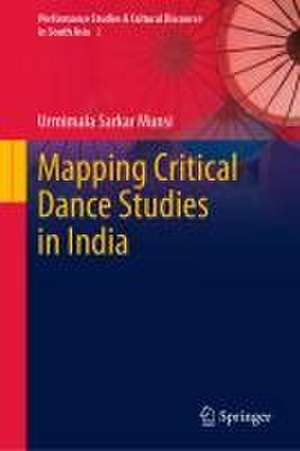Mapping Critical Dance Studies in India: Performance Studies & Cultural Discourse in South Asia, cartea 2
Autor Urmimala Sarkar Munsien Limba Engleză Hardback – 15 mar 2024
Preț: 703.85 lei
Preț vechi: 828.05 lei
-15% Nou
Puncte Express: 1056
Preț estimativ în valută:
134.68€ • 140.62$ • 111.47£
134.68€ • 140.62$ • 111.47£
Carte tipărită la comandă
Livrare economică 04-18 aprilie
Preluare comenzi: 021 569.72.76
Specificații
ISBN-13: 9789819973583
ISBN-10: 9819973589
Ilustrații: XXV, 285 p. 37 illus., 5 illus. in color.
Dimensiuni: 155 x 235 mm
Greutate: 0.61 kg
Ediția:2024
Editura: Springer Nature Singapore
Colecția Springer
Seria Performance Studies & Cultural Discourse in South Asia
Locul publicării:Singapore, Singapore
ISBN-10: 9819973589
Ilustrații: XXV, 285 p. 37 illus., 5 illus. in color.
Dimensiuni: 155 x 235 mm
Greutate: 0.61 kg
Ediția:2024
Editura: Springer Nature Singapore
Colecția Springer
Seria Performance Studies & Cultural Discourse in South Asia
Locul publicării:Singapore, Singapore
Cuprins
Introduction: All that is Dance.- Bodies that Dance: Critical Frames of Reference.- Understanding Categorisation: The ‘Tribal’ ‘Folk’, and the ‘Classical’ Dance Forms.- Patriarchy and the [In]Visible Line of Control: Power Structures and Space Making.- The Modern and the Contemporary in the Context of Dance in India.- To be continued: Thoughts on Dance as Response, Responsibility and Resistance.- Thoughts on Purpose and Criticality.
Notă biografică
Urmimala Sarkar Munsi is a social anthropologist specialized in dance studies and a dancer/choreographer. She is A PROFESSOR AND THE CURRENT DEAN, TEACHING critical dance studies and research methodology in performance studies at the School of Arts and Aesthetics, Jawaharlal Nehru University, India. She is the president of World Dance Alliance Asia Pacific. Her latest books are Uday Shankar and his Transcultural Experimentations: Dancing Modernity, published by Palgrave MacMillan in 2022, and Alice Boner Across Arts and Geographies: Shaping the Dance Art of Uday Shankar, published by the Alice Boner Institute, Varanasi in 2021. She has co-edited the MARG 75th year Readings on Dance in 2022. Her ongoing research on survival strategies for women survivors of sexual violence has yielded many writings, among which the recent most is "Towards a Pedagogic Analysis of Dance and Movement Therapy" in The Routledge Companion to AppliedPerformance, 2021. Her essay "Being Rama: Playing a God in the Changing Times" (published in Paula Richman and Rustom Bharucha edited Performing the Ramayana Tradition: Enactments, Interpretations, and Arguments, 2021) came out of her involvement in the Global Humanities Institute and Melon Foundation funded project "Crisis of Democracy" in 2018-2019.
Textul de pe ultima copertă
This book provides a critical understanding of dance studies in India, bringing together various embodied practices identified loosely as dance. It suggests an alternative reading of the history of patronage, policies, and institutionalized understanding of categories such as classical, folk, modern, popular, and Bollywood that hierarchizes some dances as 'more' dance than others. It is of great interest to scholars looking at performing arts such as dance as a tool for identity assertions. It offers diverse possibilities of understanding dance through its inherent sociopolitical possibilities as a participatory or presentational tool for communication. The multidisciplinary approach brings together perspectives from critical dance studies, anthropology, history, and gender studies to connect embodied archives of different communities to create an intersectional methodology of studying dance in India as a powerful but marginal expressive art practice. Accessible at multiple levels, the content is relevant for undergraduate and postgraduate students, as well as researchers across dance, dance education, theatre, and performance studies.
Caracteristici
Deals with the functional perspectives of varying dance practices in India Draws attention to existing discussions on dance as an embodied expression of the political in everyday life Brings together the historical and contemporary dance in India in the current times

